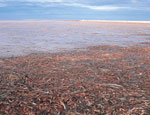 Organic matter is carbon based material derived from plants or animals (e.g. decaying plant matter or animal wastes) and can be in either dissolved or particulate form. It consumes oxygen when it degrades and is a source of ‘recycled nutrients‘ for water column productivity. It is also a source of food and energy.
Organic matter is carbon based material derived from plants or animals (e.g. decaying plant matter or animal wastes) and can be in either dissolved or particulate form. It consumes oxygen when it degrades and is a source of ‘recycled nutrients‘ for water column productivity. It is also a source of food and energy.
View a conceptual model of potential causes of a change to organic matter and the condition responses observed as a result of this change.
Potential indicators
There are a number of causes and symptoms related to this stressor. The following indicators are recommended for the stressor ‘Organic matter’:
Pressure indicators
Indicators of organic matter sources:
- Catchment land-use
- Number of point sources per km estuary
- Percentage of catchment with intensive agriculture on steep slopes
- Frequency of sewage overflow events
- Percentage of catchment under intensive animal production
- Percentage river system affected by aquatic weeds
Indicators of direct pressure:
- None
Vulnerability indicators
- Flushing rate
Condition indicators
Physical-chemical condition indicators:
- Minimum sustained dissolved oxygen values during the days following an inflow event
- Ambient dissolved oxygen
Biological condition indicators:
- Number of mass mortality events caused by low dissolved oxygen
| Possible causes | Possible symptoms |
The actions/events/situations that might induce this stress:
|
The actions/events/situations that might arise from a change to the stressor: |
Fact sheets on background science and economics
Other information on excess organic matter
International
Global Environment Monitoring System (GEMStat) is designed to share surface and ground water quality data sets collected from the GEMS/Water Global Network, including over 1,400 stations, two million records, and over 100 parameters.
Models
Australia
Simple Estuarine Response Model (SERM) is a coupled biological-physical model of estuarine response in Australian estuaries.


